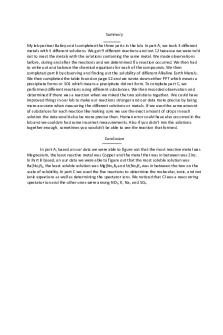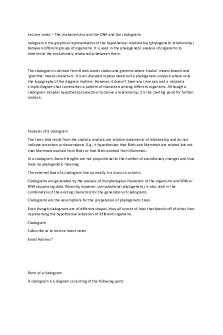Summary notes – The homologous and the chemical series PDF

| Title | Summary notes – The homologous and the chemical series |
|---|---|
| Course | Molecular & Cellular Biology |
| Institution | University of Central Lancashire |
| Pages | 4 |
| File Size | 51 KB |
| File Type | |
| Total Downloads | 59 |
| Total Views | 125 |
Summary
These are very detailed and well formatted notes that are easy to understand and revise from...
Description
Summary notes – The homologous and the chemical series The full displayed formula for the first five members of the homologous series of ALCOHOLS
The diagrams show ALL the covalent bonds (C-H, C-C, C-O and O-H) in alcohol molecules, C-OH being the alcohol functional group
The formulae can also be written as:
CH3OH, CH3CH2OH, CH3CH2CH2OH, CH3CH2CH2CH2OH and CH3CH2CH2CH2CH2OH
The general formula for this particular alcohol series is CnH2n+1OH (n = number of carbon atoms in molecule)
(Note: the technical names for the 3rd, 4th and 5th displayed above are propan-1-ol, butan-1-ol and pentan-1-ol)
Methanol, ethanol, propanol and butanol are all colourless flammable liquids that dissolve in water to give neutral solutions (pH 7)
Don't write alcohol formula as molecular formula, always give the displayed or structural formula clearly showing the alcohol functional group, which is -OH
e.g. or CH3OH, NOT CH4O and or CH3CH2OH or C2H5OH, NOT C2H6O
Revision notes on alcohols in chemistry, physical properties of alcohols like ethanol, uses of alcohols like ethanol, chemical reactions of alcohols, help when revising for AQA GCSE chemistry, Edexcel GCSE chemistry, OCR GCSE gateway science chemistry, OCR 21st century science chemistry GCSE 9-1 chemistry examinations.
TOP OF PAGE and sub-index
(2) The structure, physical properties and uses of ethanol
Ethanol and other alcohols - molecular structure, the physical and chemical properties of ethanol
or or or The first formula is the simplest formula to show the structure of ethanol and the last image is the full graphic structural displayed formula of ethanol, i.e. it shows all the atoms and the bonds linking them together in the molecule. Ethanol ('alcohol') is a colourless toxic liquid that boils at 79oC. See also Advanced Level Chemistry Notes on the Structure and Nomenclature (naming!) of alcohols Ethanol is used as a solvent, as a biofuel (can be mixed with petrol or used directly), and used to make 'ethyl esters' (see Esters page) as well as the 'potent' chemical present in alcoholic drinks! The % alcohol in wines, spirits and beer varies from 1–40%. The alcohol (ethanol) used in beer and wines is made by fermentation, NOT from ethene derived from cracking crude oil. The fermentation chemistry to produce alcoholic drinks is outlined below. Note that ethanol can be made from waste biomass (see Biofuels) TOP OF PAGE and sub-index
(3) Ethanol can be produced by fermentation of sugars
and a class experiment to illustrate the manufacture of ethanol ('alcohol') from sugar
The raw material is usually a sugar from a carbohydrate source e.g. sugar cane or sugar beet. The sugar is mixed with water and yeast at just above room temperature (30-40oC) in a reactor vessel (a big vat!) from which air (oxygen) is restricted. The yeast contains an enzyme called zymase which acts as the biological catalyst to convert sugar to ethanol in fermentation. The enzyme works best at an optimum of pH ~6. Under anaerobic conditions at an optimum temperature of 30oC to 40oC, the sugars react via the enzymes in the yeast cells to form ethanol and carbon dioxide gas. If the temperature is too low, the reaction is too slow. If the temperature is to high the enzyme is denatured - the molecular structure is distorted so the active site doesn't work properly. Oxygen from air must be excluded to maintain anaerobic conditions - the reaction is an example of anaerobic respiration. Other enzymes present can catalyse the oxidation of ethanol to ethanoic acid (acetic acid, vinegar), not a nice taste. The fermentation reaction of the sugar obtained from the sugar cane or sugar cane is ...
glucose (sugar) == enzyme ==> ethanol + carbon dioxide C6H12O6(aq) ====> 2C2H5OH(aq) + 2CO2(g) The atom economy is only 51% (see atom economy calculations) The carbon dioxide is allowed to escape and air is prevented from entering the reaction vessel to stop oxygen oxidising ethanol to ethanoic acid ('acetic acid' or vinegar!) ensuring the reaction occurs under anaerobic conditions. The acid would also lower the pH lowering the effectiveness of the enzyme and it wouldn't do the taste of beer any good either. The fermentation reactions stop when the concentration of alcohol reaches a maximum of 10-20% when the alcohol kills the yeast cells. When the reaction is over, the 'yeast sludge' settles out and the mixture decanted (poured off leaving the sludge behind) off prior to distillation. The fractional distillation (more details below) concentrates the alcohol for particular products. e.g. wine is distilled to make brandy, whisky is made from fermented grain like barley, vodka is very concentrated ethanol and is also made from fermented grain or potatoes. Some spirits have up to 40% alcohol in them, beers have about 3-4% alcohol in them - but distillation isn't necessary. Teacher note - class fermentation experiment A simple recipe for small groups of pupils: Dissolves ~10g of granulated sugar in 100 cm3 of water to make a ~10% solution. Pour into a 250 cm3 conical flask. Add a teaspoon of dried yeast. Seal the conical flask with a rubber bung and an inverted U tube Π. You can just use a cotton wool plug, but more awkward to get a gas sample to test. Keep in a warm place (if possible) between lessons. In fact after a few hours (maybe by the end of the lesson?) the student can test for carbon dioxide with limewater - the carbon dioxide should give a white precipitate with the limewater. I used to ask the students to bring some fruit juice in their school bag and add it to the solution, or make up the fruit juice to 100 ml and add the sugar and yeast. Not sure on H & S regulations on this point these days? In the next lesson I would then gather all the fermented mixtures and filter them all into a large distillation flask. I'd then perform 'with great ceremony' the fractional distillation described below. Then you demonstrate the flammability of the 'firewater' by burning the odd drop to show it was fuel. They were also allowed to smell the product, which had a lovely fruity odour.
fractional distillation diagram and theoryMore details on how is the ethanol separated from a fermented mixture The ethanol is separated from the reaction mixture by fractional distillation to make a petrol additive fuel or whisky! Ethanol has a lower boiling point (78oC) than water (100oC) and distils off first giving a concentration of up to 95% ethanol. The two vapours separate out in the fractionating column, the lower boiling ethanol rising to the top, passing out into the condenser, condensing to a liquid for collection in some suitable container. Most of the higher boiling water condenses back into a liquid in the fractionating column and runs back into the flask. This distillation is needed to make spirits like brandy and whisky. The laboratory process is illustrated in the diagram on the right using a glass column filled with glass beads and connected to the distillation flask and a Liebig condenser (see separation of mixtures - distillation for more explanation). Extra notes on the fermentation process .... The progress of the fermentation can be followed by measuring the density of the fermented liquid with a hydrometer. Ethanol/alcohol is less dense than water/sugar so the density changes as the sugar is converted into alcohol. When the concentration of alcohol reaches about 10–20% the fermentation reaction stops because the yeast cells are then killed by this high concentration of ethanol. Pure ethanol is classed as a toxic poison just like cyanide and arsenic! Its important to have the optimum temperature (30oC – 40oC) otherwise the efficiency of the process is affected. If the temperature is to high the enzymes in the yeast cells are denatured and if the temperature is too low, the reaction is too slow (see graph of rate of reaction below). The diagram (c) doc b graphically illustrates the idea of the optimum temperature by showing the rate of reaction varies for a fermentation process. The diagram (c) doc b graphically illust...
Similar Free PDFs

The Parenthood Television Series
- 13 Pages

The NACA airfoil series
- 6 Pages

Summary creation and the cosmos
- 24 Pages

Chapter 15 The Chemical Senses
- 14 Pages
Popular Institutions
- Tinajero National High School - Annex
- Politeknik Caltex Riau
- Yokohama City University
- SGT University
- University of Al-Qadisiyah
- Divine Word College of Vigan
- Techniek College Rotterdam
- Universidade de Santiago
- Universiti Teknologi MARA Cawangan Johor Kampus Pasir Gudang
- Poltekkes Kemenkes Yogyakarta
- Baguio City National High School
- Colegio san marcos
- preparatoria uno
- Centro de Bachillerato Tecnológico Industrial y de Servicios No. 107
- Dalian Maritime University
- Quang Trung Secondary School
- Colegio Tecnológico en Informática
- Corporación Regional de Educación Superior
- Grupo CEDVA
- Dar Al Uloom University
- Centro de Estudios Preuniversitarios de la Universidad Nacional de Ingeniería
- 上智大学
- Aakash International School, Nuna Majara
- San Felipe Neri Catholic School
- Kang Chiao International School - New Taipei City
- Misamis Occidental National High School
- Institución Educativa Escuela Normal Juan Ladrilleros
- Kolehiyo ng Pantukan
- Batanes State College
- Instituto Continental
- Sekolah Menengah Kejuruan Kesehatan Kaltara (Tarakan)
- Colegio de La Inmaculada Concepcion - Cebu











